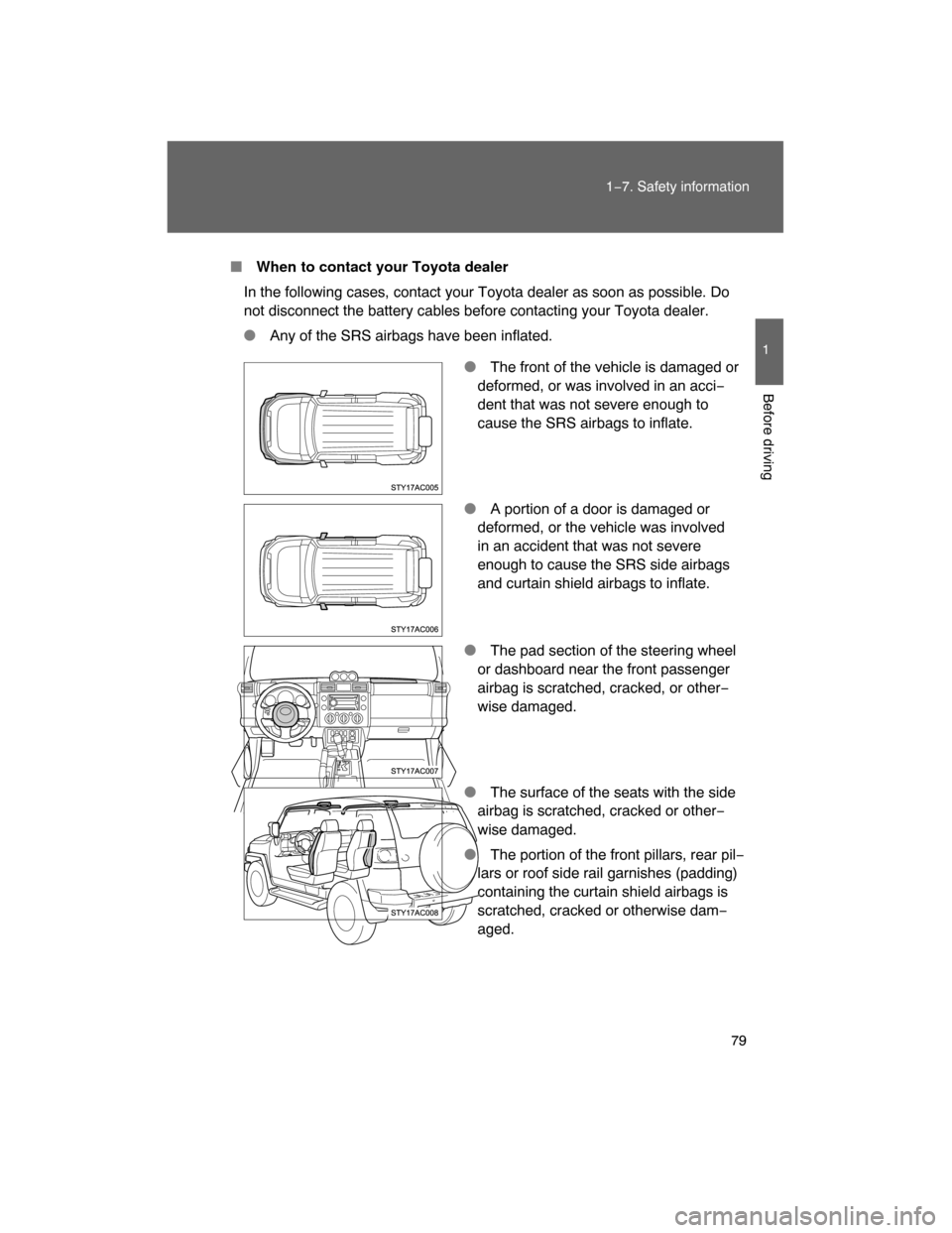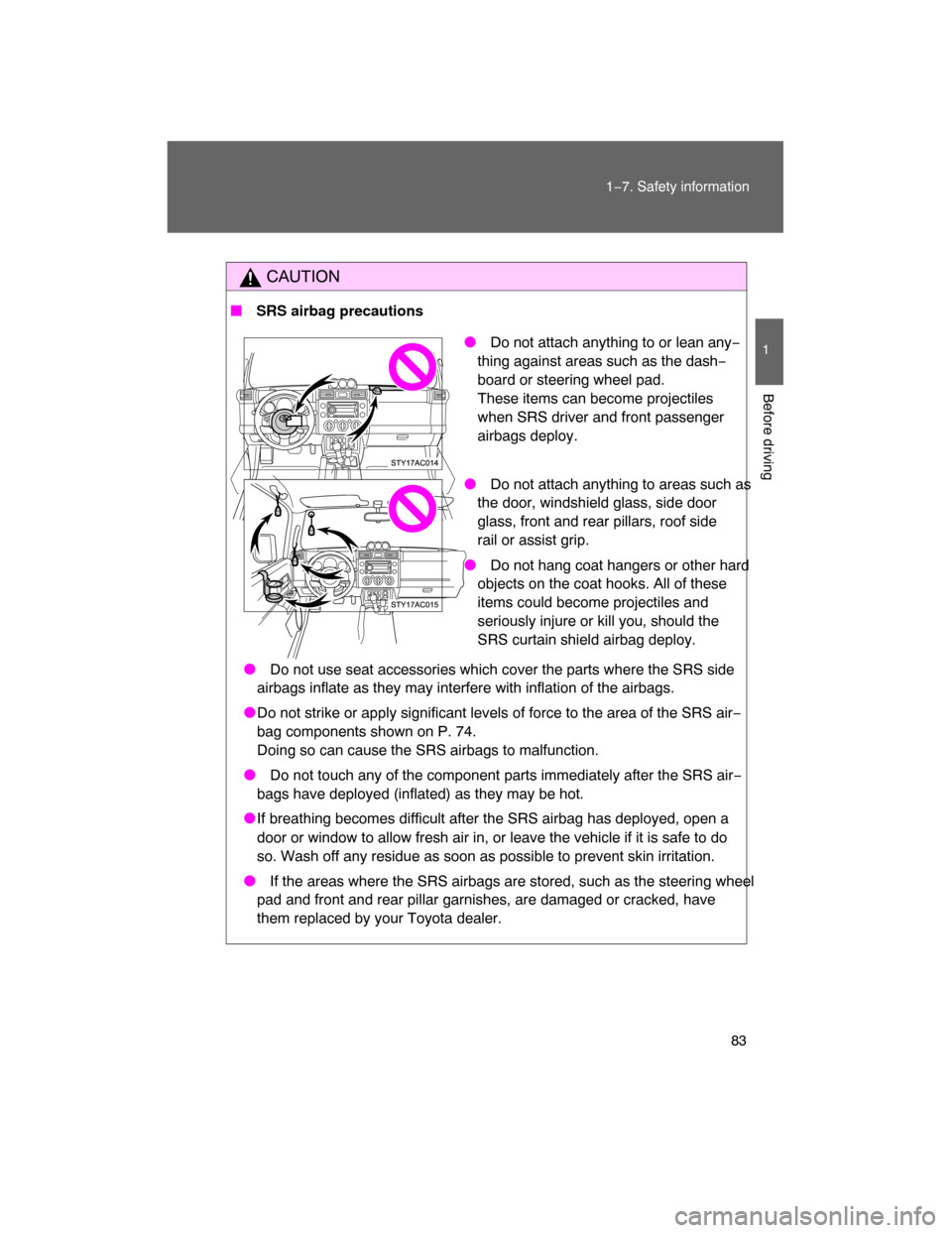Page 74 of 400

75
1−7. Safety information
1
Before driving
Your vehicle is equipped with ADVANCED AIRBAGS designed based
on US motor vehicle safety standards (FMVSS208). The airbag sys−
tem controls airbag deployment po
wer for the driver and front pas−
senger. The driver airbag system consists of the driver seat’s position
sensor etc. The front passenger ’s airbag system consists of the front
passenger occupant classification sensor etc.
The main SRS airbag system components are shown above. The
SRS airbag system is controlled by
the airbag sensor assembly. The
airbag sensor assembly consists of a safing sensor and an airbag
sensor.
In certain types of severe frontal or side impacts, the SRS airbag sys−
tem triggers the airbag inflators. A
chemical reaction in the inflators
quickly fills the airbags with non−toxic gas to help rest rain the motion
of the occupants.
� SRS warning light
This warning light system monitors the airbag sensor assembly, front airbag
sensors, side and curtain shield airbag sensor assemblies, curtain shield air−
bag sensor assemblies, driver ’s seat position sensor, driver ’s seat belt
buckle switch, front passenger occupant classification system, AIR BAG ON
indicator light, AIR BAG OFF indicator light, front passenger ’s seat belt
buckle switch, seat belt pretensioner assemblies, inflators, interconnecting
wiring and power sources. (
P. 332)
� If the SRS airbags deploy (inflate)
� Bruising and slight abrasions may result from contact with a deploying
(inflating) SRS airbag.
�A loud noise and white powder will be emitted.
�Parts of the airbag module (steering wheel hub, airbag cover and inflator)
as well as the front seats, and parts of the front and rear pillars and roof
side rail, may be hot for several minutes. The airbag itself may also be
hot.
� The front windshield may crack.
Page 78 of 400

79
1−7. Safety information
1
Before driving
� When to contact your Toyota dealer
In the following cases, contact your Toyota dealer as soon as possible. Do
not disconnect the battery cables before contacting your Toyota dealer.
� Any of the SRS airbags have been inflated.
� The front of the vehicle is damaged or
deformed, or was involved in an acci−
dent that was not severe enough to
cause the SRS airbags to inflate.
� A portion of a door is damaged or
deformed, or the vehicle was involved
in an accident that was not severe
enough to cause the SRS side airbags
and curtain shield airbags to inflate.
� The pad section of the steering wheel
or dashboard near the front passenger
airbag is scratched, cracked, or other−
wise damaged.
� The surface of the seats with the side
airbag is scratched, cracked or other−
wise damaged.
� The portion of the front pillars, rear pil−
lars or roof side rail garnishes (padding)
containing the curtain shield airbags is
scratched, cracked or otherwise dam−
aged.
Page 82 of 400

83
1−7. Safety information
1
Before driving
CAUTION
� SRS airbag precautions
� Do not use seat accessories which cover the parts where the SRS side
airbags inflate as they may interfere with inflation of the airbags.
�Do not strike or apply significant levels of force to the area of the SRS air−
bag components shown on P. 74.
Doing so can cause the SRS airbags to malfunction.
� Do not touch any of the component parts immediately after the SRS air−
bags have deployed (inflated) as they may be hot.
�If breathing becomes difficult after the SRS airbag has deployed, open a
door or window to allow fresh air in, or leave the vehicle if it is safe to do
so. Wash off any residue as soon as possible to prevent skin irritation.
� If the areas where the SRS airbags are stored, such as the steering wheel
pad and front and rear pillar garnishes, are damaged or cracked, have
them replaced by your Toyota dealer.
� Do not attach anything to or lean any−
thing against areas such as the dash−
board or steering wheel pad.
These items can become projectiles
when SRS driver and front passenger
airbags deploy.
� Do not attach anything to areas such as
the door, windshield glass, side door
glass, front and rear pillars, roof side
rail or assist grip.
� Do not hang coat hangers or other hard
objects on the coat hooks. All of these
items could become projectiles and
seriously injure or kill you, should the
SRS curtain shield airbag deploy.
Page 375 of 400

381
6−1. Specifications
6
Vehicle specifications
Tire related term Meaning
Normal occupant
weight150 lb. (68 kg) times the number of occupants
specified in the second column of Table 1
* that
follows
Occupant distributionDistribution of occupants in a vehicle as
specified in the third column of Table 1
* below
Production options
weightThe combined weight of installed regular
production options weighing over 5 lb. (2.3 kg)
in excess of the standard items which they
replace, not previously considered in curb
weight or accessory weight, including heavy
duty brakes, ride levelers, roof rack, heavy duty
battery, and special trim
RimA metal support for a tire or a tire and tube
assembly upon which the tire beads are seated
Rim diameter
(Wheel diameter)Nominal diameter of the bead seat
Rim size designation Rim diameter and width
Rim type designationThe industry manufacturer’s designation for a
rim by style or code
Rim width Nominal distance between rim flanges
Vehicle capacity
weight (Total load
capacity)The rated cargo and luggage load plus 150 lb.
(68 kg) times the vehicle’s designated seating
capacity
Vehicle maximum load
on the tireThe load on an individual tire that is determined
by distributing to each axle its share of the
maximum loaded vehicle weight, and dividing
by two
Vehicle normal load
on the tireThe load on an individual tire that is determined
by distributing to each axle its share of curb
weight, accessory weight, and normal
occupant weight (distr
ibuted in accordance
with Table 1
* below), and dividing it by two